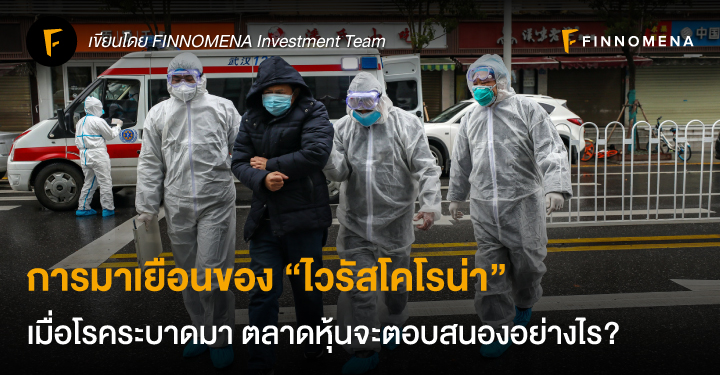การมาเยือนของ “ไวรัสโคโรน่า”:
เมื่อโรคระบาดมา ตลาดหุ้นจะตอบสนองอย่างไร?
ตั้งแต่เปิดปี 2020 มาก็มีเรื่องใหญ่ๆ ที่กระทบกับตลาดหุ้นมากมาย ตั้งแต่การสังหารนายพลคนสำคัญของอิหร่าน ไล่มาจนถึงการเซ็นต์สัญญาการค้าเฟส 1 ระหว่างสหรัฐฯ และจีนที่ลุ้นกันมานาน ในฝั่งของบ้านเมืองและความเป็นอยู่ของเราก็มีฝุ่น PM2.5 ที่กลับมาสร้างความตระหนกอีกครั้ง เท่านั้นยังไม่พอ ล่าสุดยังมีไวรัสชื่อใหม่อย่างโคโรน่ามาซ้ำเติมอีก
จากตอนแรกที่คิดว่าไวรัสนี้น่าจะจำกัดกลุ่มแค่เฉพาะในคนจีน ตอนนี้กลับกลายเป็นว่าไวรัสแพร่กระจายอย่างรวดเร็วลามมาถึงประเทศไทย สร้างความหวาดหวั่นให้หลายๆ คน รวมถึงนักลงทุนที่เกรงว่าความกลัวครั้งนี้อาจจะส่งผลกระทบต่อตลาดหุ้น รึเปล่า?
บทความนี้ขอสรุปเนื้อหาจาก FINNOMENA LIVE เมื่อวันที่ 23 มกราคม 2563 ที่ผ่านมา ซึ่งทีมงาน FINNOMENA ได้รวบรวมข้อมูลที่น่าสนใจ รวมถึงสถิติในอดีตสมัยโรค SARS และ MERS ระบาด ว่าส่งผลต่อตลาดหุ้นอย่างไรบ้าง?
ต้นกำเนิดไวรัสโคโรน่า: เมืองอู่ฮั่น (Wuhan) ประเทศจีน
พิกัดเมืองอู่ฮั่น
ที่มา: Google Maps
ไวรัสเริ่มต้นระบาดที่เมืองอู่ฮั่น ซึ่งมีประชากรประมาณ 11 ล้านคน แต่มีเพียง 8.8 ล้านคนที่เป็นผู้อาศัยถาวร
อู่ฮั่น (Wuhan) เมืองประชากรหนาแน่น ติดสถานีรถไฟ เสี่ยงไวรัสกระจายตัว
ข้อมูลประชาชนของเมืองอู่ฮั่น เส้นสีฟ้าคือประชากรทั้งหมด เส้นสีดำคือผู้อาศัยถาวร
ที่มา: Bloomberg
ความน่ากลัวอยู่ตรงนี้ หากย้อนไปดูช่วงเทศกาลตรุษจีนปีที่แล้ว สถานีรถไฟกลางของเมืองได้ให้บริการผู้โดยสารกว่า 5.5 ล้านคน นับเป็นครึ่งหนึ่งของเมืองก็ว่าได้ ซึ่งสถานีแห่งนี้ห่างจากตลาดอาหารทะเลที่เป็นจุดแพร่ระบาดเพียง 1 กิโลเมตรเท่านั้น!
กลับมาที่ปีนี้ เราอาจสรุปได้ว่า ใครที่ป่วยตอนขึ้นรถไฟ ก็อาจไปเมืองอื่นแล้ว ง่ายต่อการกระจายตัวของไวรัสมากขึ้น
ทางรัฐเพิกเฉย จ่ายงบด้านวิจัยวิทยาศาสตร์ มากกว่าสาธารณสุข
การใช้จ่ายของภาครัฐ เส้นสีดำคือด้านสุขอนามัย เส้นสีฟ้าคือด้านวิทยาศาสตร์
ที่มา: Bloomberg
อีกสาเหตุหนึ่งที่เกิดไวรัสขึ้นในเมืองอู่ฮั่น เป็นเพราะเมืองมีความแออัดระดับหนึ่ง จนปีที่แล้วมีการร้องเรียนเรื่องสุขภาพอนามัยมาตลอดแถวๆ ตรงตลาดอาหารทะเล แต่งบประมาณกลับทุ่มลงไปกับ เรื่องเทคโนโลยีมากกว่าสุขอนามัย ไร้การตอบรับจากภาครัฐโดยสิ้นเชิง
อัตราการแพร่กระจายของไวรัสโคโรน่า ณ ปัจจุบัน
แผนที่แสดงการกระจายตัวของเชื้อทั่วโลก
ที่มา: Bloomberg
ข้อมูลปัจจุบัน ณ วันที่ 27 มกราคม 2563 มีรายงานผู้ติดเชื้อจำนวน 2,797 ราย และมีผู้เสียชีวิตแล้วจำนวน 80 รายทั่วโลก โดยจำนวนผู้ติดเชื้อสูงสุดอยู่ในประเทศจีน และมีการกระจายตัวไปทั่วโลกแต่อยู่ในอัตราที่ไม่มาก โดยอยู่ที่จำนวนน้อยกว่า 10 ราย โดยประเทศอื่นๆนอกจากจีนที่พบผู้ติดเชื้อประกอบไปด้วย ประเทศแถบอเมริกาเหนือ อเมริกาใต้เล็กน้อย ฝรั่งเศส ไทย ออสเตรเลีย ญี่ปุ่น เวียดนาม มาเลเซีย บรูไน และอื่นๆ
ย้อนอดีตไปดูผลกระทบของ SARS และ MERS ต่อเศรษฐกิจโลก
ในปี 2003 ไวรัส SARS ระบาดครั้งแรกในมณฑลกวางตุ้ง ประเทศจีน ผลกระทบคือ GDP ฮ่องกง ติดลบไปประมาณ 2.5% ในขณะที่จีนลบไปประมาณ 1% ซึ่งก็สะท้อนให้เห็นความกลัวของผู้คน เพราะเมื่อเกิดโรคระบาดทางรัฐจะมีมาตรการจำกัดพื้นที่ เพื่อควบคุมการแพร่กระจายของเชื้อ เช่น ให้ผู้คนอยู่แต่ในที่พักอาศัยของตนเท่านั้น ส่งผลให้คนไม่สามารถออกไปจับจ่ายใช้สอยอย่างที่เคยเป็น ไม่ออกไปเที่ยว การส่งออก (Export) ก็ย่อมหายไป
ผลกระทบของโรคระบาด SARS ต่อ GDP แต่ละประเทศ
ที่มา: Reuters
แต่ถึงอย่างนั้น เศรษฐกิจก็ดิ่งได้ไม่นานนะ แม้ช่วงที่ SARS ระบาด การค้าปลีกจีนจะลดลงแทบจะทันที แต่พอบอกว่าควบคุมได้แล้ว การจับจ่ายใช้สอยก็วิ่งกลับขึ้นมาทันทีเช่นกัน
ลงทุนในกองทุนรวมที่ยอดเยี่ยม ปรึกษา FINNOMENA ฟรี! ไม่มีค่าใช้จ่าย เพราะเป้าหมายการลงทุนแตกต่างกัน จึงต้องใส่ใจในทุกรายละเอียด
ดูพอร์ตกองทุนแนะนำ
การจับจ่ายใช้สอยของผู้บริโภคจีน ลดลงช่วงที่เกิดการแพร่ระบาดของ SARS
ที่มา: Reuters
ผลกระทบของ SARS และ MERS ต่อผู้คน
โรค MERS ระหว่างปี 2012 – 2015 มีผู้ติดเชื้อ 2,400 ราย มีอัตราผู้เสียชีวิตที่ 35%
ในช่วง 20 วันแรก โรค SARS มีผู้ติดเชื้อ 95 ราย และพุ่งขึ้นเป็น 8,000 รายในระยะเวลาต่อมา ส่วนของโคโรน่าในช่วง 20 วันแรกอยู่ที่ 219 ราย เห็นตัวเลขนี้แล้วสยองเลย เพราะดูแล้วแพร่กระจายรวดเร็วกว่า SARS จริงๆ
จำนวนผู้ที่ติดโรค SARS (สีเหลือง) และจำนวนผู้เสียชีวิต (สีดำ) แยกตามประเทศ
ที่มา: Reuters
ผลกระทบของ SARS และ MERS ต่อตลาดหุ้น
ตอนพบผู้ป่วย SARS รายแรก ตลาดหุ้นยังไม่ได้รับผลกระทบเท่าไร จนกระทั่งทางรัฐบาลจีนรายงานสถานการณ์ต่อ WHO เท่านั้นแหละก็ทำให้ทั้งโลกรับรู้ถึง SARS หลังจากนั้นตลาดหุ้นดิ่ง ภายในประมาณ 1 เดือน โดย MSCI World ลบ 11% และใช้เวลาฟื้นตัว 1 เดือน
ทางด้าน Global Airline Index (หุ้นสายการบิน) ก็ลงไป 17% ใช้เวลา 61 วันกว่าจะฟื้นกลับมาที่จุดเดิมก่อนที่ WHO จะประกาศเรื่องโรค SARS
ผลกระทบของโรค SARS ต่อตลาดหุ้นในแต่ละช่วงเวลา
ที่มา: FINNOMENA
หันไปทางฝั่ง MERS ด้วยเพราะอัตราแพร่ระบาดที่ต่ำกว่า ตลาดเลยไม่ค่อยตอบรับ มีลบบ้างนิดหน่อย แล้วฟื้นตัวเป็นบวกทันที
ผลกระทบของโรค MERS ต่อตลาดหุ้นในช่วงเวลาต่างๆ
ที่มา: FINNOMENA
ตลาดหุ้นไทยโดนผลกระทบจากโรค SARS ลบไป 21% ขณะที่ MERS ลบไป 6%
ผลกระทบของโรค SARS และ MERS ต่อตลาดหุ้นไทย
ที่มา: FINNOMENA
สถานการณ์ CSI300 จนถึงปัจจุบัน นับตั้งแต่รู้เรื่องโรคระบาดวันที่ 31 ตอนนี้ลบมาแล้ว 4.76%
CSI300 หลังเจอผลกระทบของไวรัสโคโรน่า
ที่มา: Bloomberg
แล้วสถานการณ์ปัจจุบัน นักลงทุนควรทำอย่างไร?
นักลงทุนควรที่จะจับตามองสถานการณ์อย่างใกล้ชิดเนื่องจากการแพร่กระจายของไวรัสโคโรน่า ณ ปัจจุบันยังไม่สามารถคาดเดาได้ ซึ่งหากเทียบกับสถานการณ์การระบาดในอดีตของโรค SARS และ MERS นั้น ผลกระทบที่มีต่อตลาดหุ้นนั้นขึ้นอยู่กับอัตราการแพร่กระจายของเชื้อ ดังนั้นหากสถานการณ์สามารถควบคุมได้โดยเร็ว ก็มีความเป็นไปได้ว่าตลาดหุ้นจะปรับตัวขึ้นดังเดิมได้เร็วขึ้น
สรุปโดยรวมถือว่าการระบาดของไวรัสโคโรน่ายังเป็นปัจจัยที่อาจส่งผลกระทบในระยะสั้น ส่วนในมุมมองระยะกลางถึงยาว ตลาดหุ้นยังมีความน่าสนใจอยู่
FINNOMENA Investment Team






























